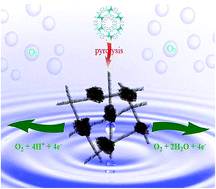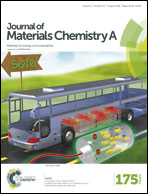An Fe–N–C hybrid electrocatalyst derived from a bimetal–organic framework for efficient oxygen reduction†
Abstract
A simple Zn/Fe bimetallic zeolitic–imidazolite framework (ZIF) carbonization method is developed to synthesize an Fe–N–C hybrid with hierarchical nitrogen-doped porous carbons crossed by carbon nanotubes. Both the specific ratios of Zn/Fe in the bimetallic metal–organic framework (MOF) precursors and the selected annealing temperature are essential for the formation of this unique hybrid structure with good conductivity and exposure of more active sites. The resulting FeNC-20-1000 hybrid electrocatalyst exhibits excellent oxygen reduction reaction (ORR) activity, with a half-wave potential of 0.770 V comparable to that of the commercial Pt/C catalysts in acidic media, and a half-wave potential of 0.880 V, ca. 50 mV more positive than that of Pt/C for ORR in alkaline solution. More importantly, the as-prepared Fe–N–C hybrid exhibits much more stability for the ORR in both acidic and alkaline solutions than Pt/C, which makes it among the best non-noble-metal catalysts ever reported for ORR under acidic and alkaline conditions.


 Please wait while we load your content...
Please wait while we load your content...